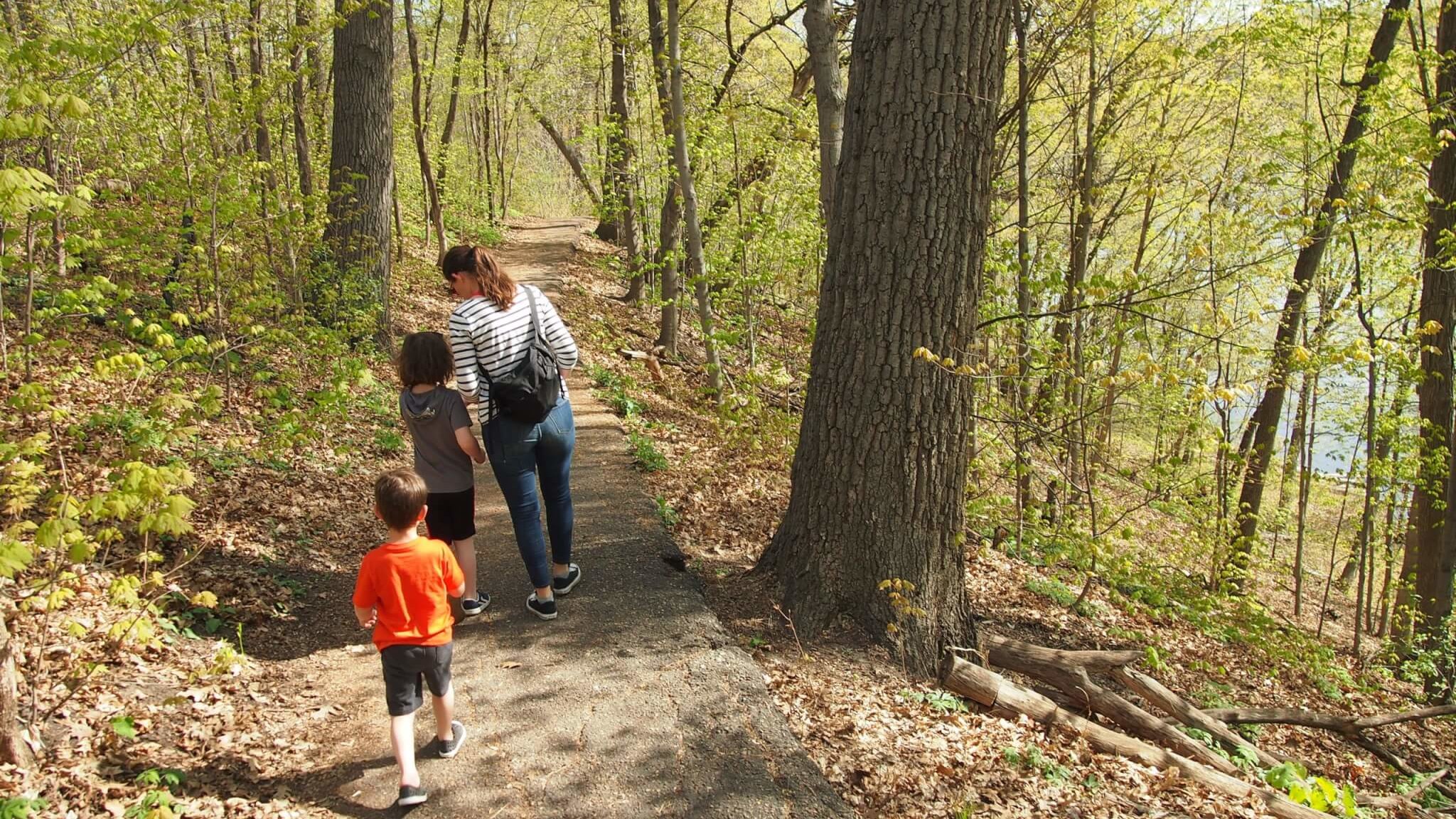There is an endless list of reasons to spend time in nature, but a growing body of research points to the benefits of exposure to the natural world on our health, reducing stress, and promoting healing. With so much uncertainty still circulating in our daily lives, we’d like to share a few ways in which nature can heal and suggest five locations in Minneapolis parks to feel its benefits.
#1. Listen to the Flowing Water at Shingle Creek Falls or the Birds at North Mississippi Regional Park


Listening to the sounds of flowing water near a creek or waterfall, or sounds like birdsong have shown to alleviate stress, help lower blood pressure, improve cognitive performance, and even reduce pain, as published in Rachel Buxton’s research, A Synthesis of Health Benefits of Natural Sounds and their Distribution in National Parks. Buxton’s team found that bird sounds proved best at alleviating stress and annoyance, while water sounds boosted both overall health outcomes and positive emotions like tranquility.
Throughout Minneapolis parks, we are lucky to find numerous areas with natural water sounds, including creeks, rivers, and some spectacular waterfalls. While the draw of Minnehaha Falls might offer a similar stress-reliever, we’d also recommend opting for the more secluded, smaller waterfall in North Minneapolis, Shingle Creek Falls. The force of water falling over the edge is almost mesmerizing to watch, but don’t forget to take a moment to just listen.
North Mississippi Regional Park is a 67-acre park located along the Mississippi River, which offers spectacular scenery of the river and surrounding woods and prairie. It is an intimate, enclosed, natural setting that serves as a common resting point for migratory birds, as well as a home for many nonmigratory birds. The variety of tweets heard in this lush area create a symphony of birdsong.
You May Also Be Interested in:
5 Parks to Catch Sight of Winter Birds
Spring Migrating Birds on the Minneapolis Riverfront
Soundscapes from Three Minneapolis Parks
#2. A Walk Around Diamond Lake

A study by forest-theory expert, Yoshifumi Miyazaki, found that those who had spent 40 minutes walking in a forest had lower levels of the stress hormone cortisol in their body (which is involved in blood pressure and immune-system function) as compared with those who spent 40 minutes walking indoors.
There are endless trails to explore in Minneapolis Parks, but one beautifully wooded path to walk is around Diamond Lake Park. At 81 acres, the delicate ecosystem of Diamond Lake Park and surrounding wetlands and wooded areas is home to a variety of aquatic creatures and provides a needed respite for migratory waterfowl. This little oasis brings an immediate sense of calm from the city life just beyond the trees.
You May Also Be Interested in:
Soundscapes from Three Minneapolis Parks
#3. Stop to Smell the Flowers at The Longfellow Gardens

Dr. Qing Li, a professor at the Nippon Medical School in Tokyo, found that trees and plants emit aromatic compounds called phytoncides, and that, when inhaled, can spur healthy biological changes in a manner like aromatherapy, which has also been studied for its therapeutic benefits.
The late summer flowers at the Longfellow Gardens are not only a beautiful sight to see but also offer an astounding array of smells. As you step into the garden, the bright, fruity smells filling the air are an immediate comfort. Close your eyes, take a few deep breaths, and let nature heal.
You May Also Be Interested in:
8 Pollinator Friendly Plants at Longfellow Gardens
#4. Admire the Towering Trees at Eloise Butler Wildflower Garden

In a 2015 study, researcher Paul Piff of the University of California, Irvine, found that people who spent 60 seconds looking up at towering trees were more likely to report feeling awe and, subsequently, were more likely to help a stranger than people who looked at an equally tall – but far less awe-inspiring – building.
The sky-scraping, majestic evergreens, planted over a century ago at Eloise Butler Wildflower Garden, offer a particular vantage point not so common in Minneapolis. Take a moment here to appreciate the magnitude and history these trees have lived through, each year growing just slightly more as the world around them changes tenfold. There’s a peacefulness that radiates from within these gentle giants.
You May Also Be Interested in:
Heritage Trees of Minneapolis Parks
An increasing number of healthcare providers are also embracing the back-to-nature paradigm. One organization, Park RX America, founded by Robert Zarr of Unity Healthcare in Washington, D.C., declares its mission “to decrease the burden of chronic disease, increase health and happiness, and foster environmental stewardship, by virtue of prescribing Nature during the routine delivery of healthcare by a diverse group of health care professionals.” The organization has 10,000 parks in its “prescribing platform.” In May of 2019, Robert Zarr joined us in Minneapolis to present at our signature Next Generation of Parks Event Series – check out Dr. Zarr’s full presentation here.
For resources from this Listicle, as well as additional information on the healing powers of nature, check out these online publications.
https://www.pnas.org/content/118/14/e2013097118
https://time.com/4405827/the-healing-power-of-nature/
https://www.takingcharge.csh.umn.edu/how-does-nature-impact-our-wellbeing
https://e360.yale.edu/features/ecopsychology-how-immersion-in-nature-benefits-your-health
https://greatergood.berkeley.edu/article/item/what_happens_when_we_reconnect_with_nature
https://www.smithsonianmag.com/science-nature/why-listening-sounds-nature-can-be-restorative-180977397/

